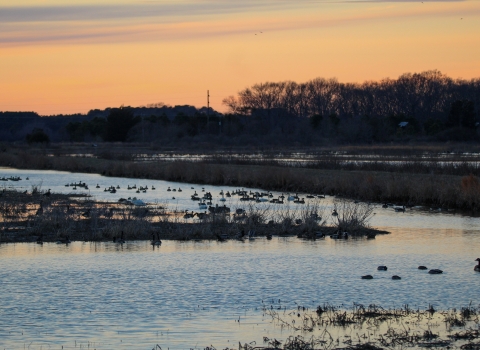The U.S. Fish and Wildlife Service (Service) and the Arizona Game and Fish Department (AGFD) will release a pair of Mexican wolves into the Blue Range Wolf Recovery Area of Arizona. In a separate action, the Service will also release a second pair of Mexican wolves into the wolf recovery area in New Mexico. Both pairs, selected to increase genetic diversity of the wild wolf population, were previously held at the Service’s Sevilleta National Wildlife Refuge Wolf Management Facility where they have undergone an acclimation process to determine that they are suitable release candidates. “We continue to be committed to strategic releases that improve genetic diversity, increase the number of breeding wolves, and offset illegal mortalities in the Blue Range Wolf Recovery Area,” said Benjamin Tuggle, the U.S. Fish and Wildlife Service’s Southwest Regional Director. “We’re excited to be working with our partners on this simultaneous release of Mexican wolves in Arizona and New Mexico. This dual release is another step that helps us reach our goal of a self-sustaining wild wolf population.” Arizona Game and Fish Department Director Larry Voyles added: “The strategically-planned release of the wolf pair into Arizona is to improve the genetic integrity of the wolf population. The release approaches being used are tailored to encourage these wolves to acclimate and behave as wild wolves. Our experience shows that wild- born, wild-raised wolves have a much better chance at success.” In Arizona, the Interagency Field Team (IFT) will conduct a “soft release” of Mexican wolves F1126 and M1051 (F indicates female and M indicates male) near the Corduroy Creek Release site on the Alpine Ranger District in the Apache National Forest. A soft release is when the wolves are taken from the wolf management facility where they have been held and transported to holding pens erected at their release locations. After a length of time (TBD) the pens will be opened and they will be released. A hard release is when the wolves are transported by crate to the release site, the crate door is opened, and the wolf is released directly into the wild.
“We considered several factors in the selection of the release site, including appropriate prey density, distance from occupied residences, seasonal absence of livestock grazing, and occurrence of established wolf packs in the area,” said Chris Bagnoli, the AGFD’s IFT leader. “This particular site was also chosen in close coordination with the public and with approval from the Forest Service.” The Arizona pair will be released into an enclosure and held for a time to acclimate them to their surroundings. After a period of time they will be released into the primary recovery zone in compliance with the existing federal 10(j) rule covering the reintroduction project because F1126 does not have previous wild experience. This will be an initial release of F1126 and a translocation of M1051.
The Service, in cooperation with the IFT, will also conduct a “modified soft release” of Mexican wolves F1108 and M1133 into New Mexico. These wolves will be translocated to an enclosure in the Gila Wilderness. The enclosure is intentionally designed so that the wolves can chew through and self-release any time after being placed there. Thus, the wolves may remain in the enclosure for less than 24 hours, or may release up to several weeks later. Both F1108 and M1133 have previous wild experience, and so are able to be translocated into the secondary recovery zone in compliance with the existing federal 10(j) rule covering the reintroduction project.
For both the Arizona and New Mexico pairs the IFT anticipates the wolves will begin utilizing the area around the release sites upon release. The IFT will provide supplemental food while the wolves learn to catch and kill native prey, such as deer and elk, on their own. The supplemental feeding will assist in anchoring the wolves to the area.
The IFT estimates the 2012 population of Mexican wolves in the wild to be a minimum of 75 animals, as determined by their most recent annual survey conducted in January 2013, up from a count of 58 in 2011.
The Reintroduction Project partners are AGFD, White Mountain Apache Tribe, USDA Forest Service and USDA Animal and Plant Health Inspection Service – Wildlife Services, several participating counties in Arizona, the Eastern Arizona Counties Organization, and the Service.
The Arizona Game and Fish Department’s mission is to conserve Arizona’s diverse wildlife resources and manage for safe, compatible outdoor recreation opportunities for current and future generations.


